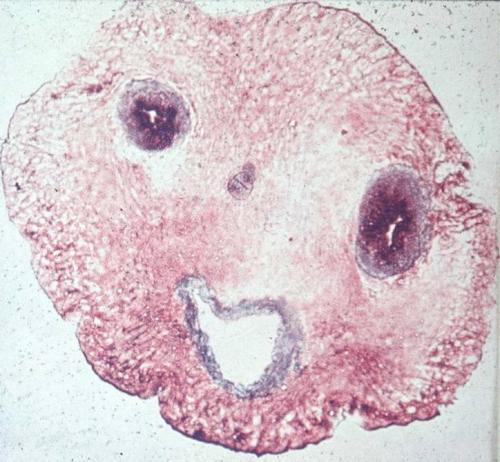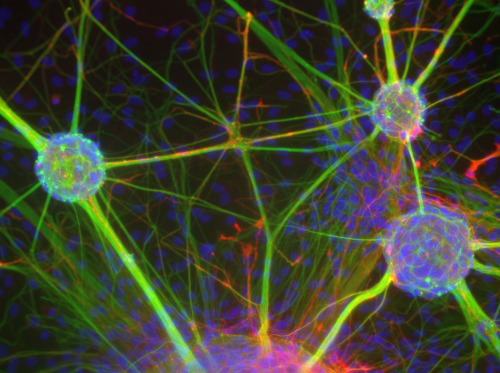Две мои любимейшие темы в одном чудесном посте. Автор - Ed Yong
All of our cells are staffed by armies of executioners. They are usually restrained but when unleashed, they can set off a fatal chain reaction that kills the cell. This suicide squad does away with billions of cells every day. It helps to balance the production of new cells with the loss of old ones, to sculpt growing tissues and to destroy potential cancer cells.
But a new study suggests that the executioners aren't always lethal. In fact, they're essential for life. Through the unorthodox method of damaging our DNA, they can actually activate important genes. This technique for switching genes on is new to science but it's apparently vital for allowing some types of stem cell to produce new types of tissue.
Stem cells are bundles of untapped potential, with the ability to produce hundreds of specialist cells across the body. This process is called differentiation. Its details vary depending on which type of cell is being produced, but scientists have recently found that some aspects are apparently common to all tissues, be they muscle, blood or bone. Surprisingly, one of these is the recruitment of executioner proteins - caspases.
Caspases cut up other proteins and in doing so, some of them produce yet more caspases. The result is a growing army of death, hacking and slashing its way through the cell. But one of these killers - caspase-3 - is a necessary part of differentiation. Get rid of it and, suddenly, stem cells can't produce their specialised daughters. Now, thanks to Brian Larsen from the Sprott Centre for Stem Cell Research, we know why.
Caspase-3 activates a protein called CAD (or caspase-activated DNase in full) by slicing apart other proteins holding it at bay. Once released, CAD lives up to its villainous acronym. It pairs up with an identical twin to create a molecule that looks and acts like a pair of scissors. The pair can cut DNA, cleaving the famous double helix in two. These sorts of cuts are normally very bad news for a cell. If they aren't repaired quickly and accurately, the consequences can include death or cancer.
But Larsen has found that stem cells deliberately break their own DNA by recruiting caspase-3 and CAD. This act of self-harm switches on important genes that are needed for differentiation; without it, the generalist cells can't specialise. This is an entirely new way of activating genes and it appears to be both important and widespread.
Larsen studied stem-like cells called myoblasts, which give rise to various types of muscle cells. As the myoblasts differentiated, Larsen watched for signs of shattered DNA using a clever test called the 'comet assay'. The technique involves puncturing a cell and placing it in an electric field. The field drives DNA through the punctured cell but only if it has already been broken into small pieces. If it has, it appears as a streak outside the cell, rather like the tail of a comet.
Sure enough, the comet test revealed that differentiating cells suffer from significant amounts of damaged DNA. Thankfully, the injuries are only temporary and the cells soon marshal their repairmen to fix the breaks.
The myoblasts need these breaks to produce muscle fibres and to create the breaks, they rely on caspase-3 and its ability to activate CAD. Larsen managed to block the development of muscle fibres by dousing myoblasts with chemicals that neutralise caspase-3. The same thing happened if he used cells with mutant versions of CAD, which couldn't be activated. In both cases, the cells failed to show any signs of broken DNA.
CAD targets a gene called p21 that's absolutely necessary for the development of muscle and plenty of other tissues. Larsen found that CAD cuts p21's 'promoter', a stretch of DNA lying next to the gene that's responsible for switching it on. Somehow, these cuts activate the gene. It's still not clear how this works, but Larsen has some ideas. The cuts could change how the surrounding DNA is packaged, exposing the p21 gene and making it easier to 'read'. Alternatively, the cuts could remove chemical 'marks' attached to the DNA that would otherwise silence it.
Damaging your own DNA may seem like a rather extreme tactic for a cell to take but it's not unheard of as a deliberate ploy. Whenever we face new infections, our body generates antibodies by breaking the DNA of special genes, stitching them back together in new combinations. That's a very controlled process, but so is the damage that leads to differentiation. It's a careful surgical strike, rather than a shock and awe campaign.
During differentiation, Larsen found that DNA breaks are actually few and far between. They appear to be carefully orchestrated so that the entire genome doesn't become a shattered mess. This precision is even more remarkable when you consider that CAD cuts DNA indiscriminately, with little care for specific sequences. Larsen thinks that CAD is constrained by the way the DNA is packaged, so that only places that are meant to be cut are exposed for slicing and dicing. Only further experiments will tell if he is right.
Reference: Larsen et al. 2010. Caspase 3/caspase-activated DNase promote cell differentiation by inducing DNA strand breaks. http://dx.doi.org/10.1073/pnas.0913089107
Статья с http://scienceblogs.com/notrocketscience/2010/02/our_cells_produce_new_tissues_by_recruiting_executioners_to.php
25.02.2010
Отличный пост о повреждениях ДНК и стволовых клетках
Подписаться на:
Комментарии к сообщению (Atom)











0 +:
Dí lo que piensas...